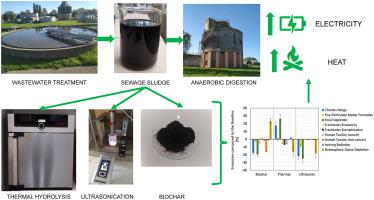Journal of Cleaner Production ( IF 9.7 ) Pub Date : 2021-09-17 , DOI: 10.1016/j.jclepro.2021.129056 Matia Mainardis 1 , Marco Buttazzoni 1 , Fabian Gievers 2, 3 , Charlene Vance 4 , Francesca Magnolo 5 , Fionnuala Murphy 4 , Daniele Goi 1

|
In this work, different pretreatment technologies (low temperature thermal treatment, ultrasonication, alkali treatment, combined alkali-thermal treatment, icing-thawing) were investigated together with biochar addition to increase biogas yield from sewage sludge. The aim of the work was to develop a standardized protocol, including physicochemical characterization, biochemical methane potential (BMP) tests, digestate characterization, life cycle assessment (LCA) and economic analysis, to verify the techno-economic suitability and the related environmental impacts of upgrading conventional full-scale anaerobic digesters. Low-temperature (65–85 °C) thermal pretreatment showed the best performances in enhancing sludge solubilization and methane yield (up to 110%), followed by ultrasonication (up to 53%) and biochar addition (about 16%). The solubilization rate obtained after each pretreatment was similar for municipal and industrial sludge; however, it did not correspond to a proportional increase in methane yield. LCA showed that ultrasonication led to the worst environmental impacts at laboratory scale, due to the huge electricity request; however, at full-scale conditions, green-house gases (GHG) emissions could be reduced by 22%, fossil depletion by 25% and stratospheric ozone depletion by 18%, when compared to the baseline scenario (raw sludge anaerobic digestion). The economic analysis proved that the high ultrasonication capital costs could not be recovered in the considered timeframe (15 yr), while biochar price should be significantly lowered (down to 6.5 €/ton) to give an overall positive outcome. Finally, the thermal scenario would be convenient only when considering waste heat recovery. The proposed protocol, including physicochemical sludge characterization, BMP tests, digestate characterization, LCA and economic analysis, could be extended to other existing digesters to compare alternative pretreatment strategies, enhancing renewable energy generation in biogas form.
中文翻译:

用于沼气生产的污水污泥预处理的生命周期评估:从实验室测试到全面适用
在这项工作中,研究了不同的预处理技术(低温热处理、超声波处理、碱处理、碱-热处理联合处理、冰-融)以及添加生物炭以提高污水污泥的沼气产量。这项工作的目的是制定一个标准化的协议,包括物理化学表征、生化甲烷潜力 (BMP) 测试、消化物表征、生命周期评估 (LCA) 和经济分析,以验证技术经济适用性和相关的环境影响。升级传统的全尺寸厌氧消化器。低温(65-85°C)热预处理在提高污泥溶解度和甲烷产率(高达110%)方面表现出最佳性能,其次是超声波处理(高达53%)和生物炭添加(约16%)。每次预处理后获得的城市污泥和工业污泥的增溶率相似;然而,它并不对应于甲烷产量的成比例增加。LCA 表明,由于巨大的电力需求,超声波处理导致实验室规模的环境影响最严重;然而,在全尺度条件下,与基线情景(原始污泥厌氧消化)相比,温室气体 (GHG) 排放量可以减少 22%,化石消耗量减少 25%,平流层臭氧消耗量减少 18%。经济分析证明,在所考虑的时间范围内(15 年)无法收回高昂的超声处理资本成本,而生物炭价格应显着降低(降至 6.5 欧元/吨)以提供总体积极的结果。最后,只有在考虑余热回收时,热方案才会方便。拟议的协议,包括物理化学污泥表征、BMP 测试、消化物表征、LCA 和经济分析,可以扩展到其他现有的消化器,以比较替代预处理策略,增强沼气形式的可再生能源发电。











































 京公网安备 11010802027423号
京公网安备 11010802027423号